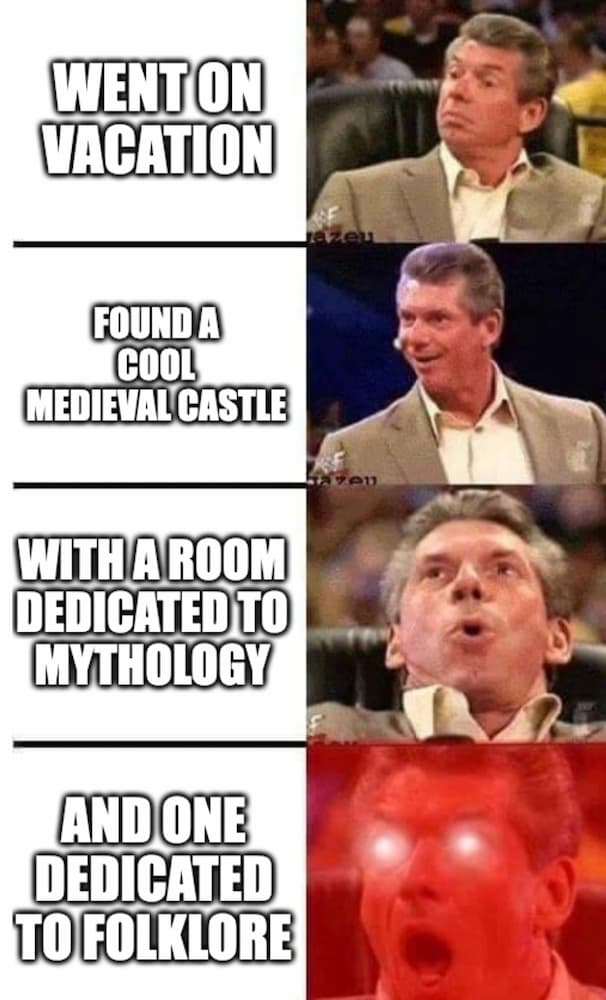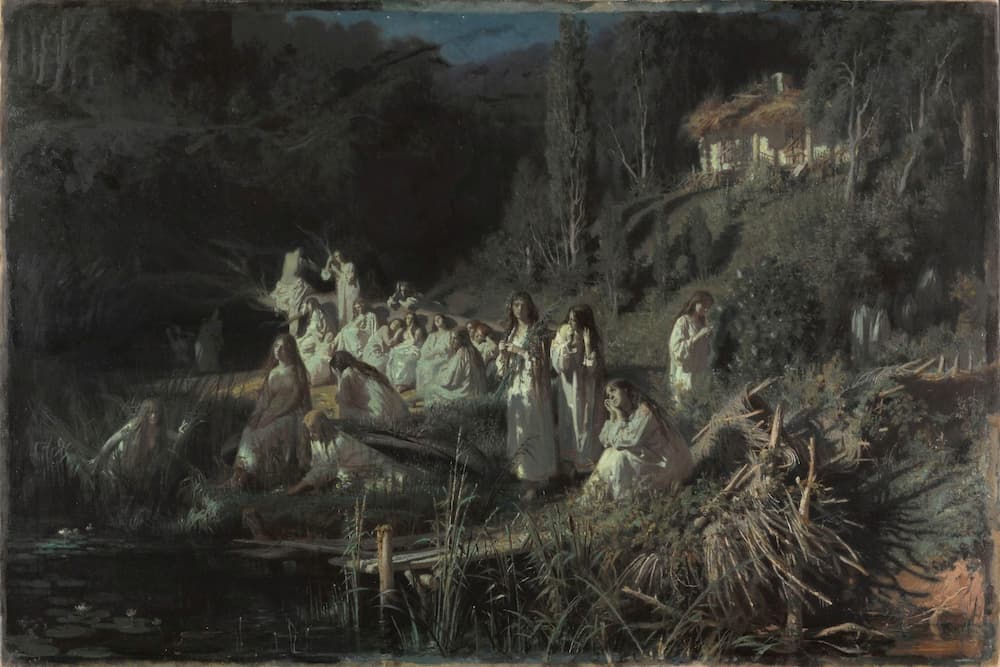During my last vacation in France, we came across one of the dozens of medieval castles open to visitors: the Château de Puymartin. The structure itself was amazing to visit, but with great surprise I found a couple of floors of the ancient tower full of mythological paintings and related panels. Needless to say, we spent at least thirty minutes over there. Then, walking up to the next level, my mind was blown: there were two whole rooms dedicated to the local folklore! 🤯

To quote George and his coffee… “What else?”
Among many interesting insights, there were some about the mysterious figure of a woman, dressed in white, that haunted the castle. On the panels, she was referred as White Lady. I immediately thought about a “local ghost”, but reading on, I discovered that this figure is much more spread than I thought. This article will focus on this being and some other ghastly findings proper to the spooky season. 👻
The Washerwomen #
Reported sightings of spectral figures dressed in white come from all over the world, and understandably inspired a gazillion different stories. The White Ladies were first “reported” in Europe in the Middle Ages in the form of fairies or supernatural creatures. They were often linked with other eerie creatures as goblin and forest spirits, and they weren’t always seen as malevolent.
They were, indeed, linked to to water: White Ladies always appeared at night, by a river, alone or in a group of washerwomen. Because of that, they have been linked with Melusines and, later, with Undines, creatures with their half lower body of a fish or serpent. These particular two were spread in France and Germany, but beings with these characteristics have always filled mankind’s imagination. Each region of the world has its own legends and names: Selkies (Shetlands), Merrows and Mermaids (Ireland), Morgen (Wales), Sirens (Greece), and Rusalki (Slavic countries) have always depicted creatures deeply linked with water.
Long before Christianity, water was venerated and linked to the feminine figure. Then, the Church condemned any pagan apparition as demonic, and introduced some confusion between fairies and witches, virgins and saints,… washerwomen and White Ladies. Nowadays, however, there are still plenty of places associated with cults of nature, water and healing.

“Rusalki”, or “The Mermaids”, by Iwan Kramoskoi, 1871. (Wikimedia Commons)
Focusing on the White Ladies, they can be found in many tales from Celtic culture and Southern Europe. They were seen as ghosts, or messengers, of young women dead in tragic circumstances. They came from noble families, so the spirits were mostly found around castles. After the French Revolution in 1789, mistrust rose against nobility, and castles became sources of legends with curses, ghosts,… and wolves — we’ll see that in a minute. The Ladies’ representation, since they were linked to the places they haunted, then changed consequently: they became ghosts of women who had buried their husbands in dirty shrouds, or mothers who had killed their children… and were depicted as silent, or shrieking funeral laments, to announce a future death — as Banshees.
Dance Owl Night #
Many lonely or nocturnal animals, because of their –at the time– inexplicable behavior, were deeply linked with supernatural appearances. Wolves were extremely dangerous for both man1 and grazing animals, so they quickly were bounded with evil forces, or witches. These animals were so feared that only gods could control them, as Dazbog, who was called “Shepard of Wolves”. He was pictured as a lame old man without an eye — like Odin, being without an eye meant to be able to see into the Spirit World.
The cat, especially if black, is the most notorious example of animal associated to witches. In The Golden Bough, Frazer tells some examples of how that poor animal was treated when corn was harvested. They were also believed to have some magical powers: if a farmer hurt himself, he had the cut licked by a cat.

This card from 1907 sums up Halloween quite well. (Wikimedia Commons)
However, the animal that was most linked with White Ladies was the Barn Owl. Its plaintive, almost human, cry was associated with the terrifying howl of the wolf on the edge of the dark forest. Also, its nocturnal life and ghostly pallor surely didn’t help to get fondness by folks. The barn owl is often seen as an ill-omen, a White Lady, an intimate of evil spirits. In Spain, it was believed that those birds drank oil from lanterns in churches, leaving priests in total darkness — this explained why they hated daylight. So, hunters killed the owls and hanged them just outside the buildings, to avoid them to enter again.
Here are some more European myths starring this poor bird:
If a pregnant woman sees a barn owl and doesn’t kill it, her baby will die.
Whoever opens their mouth in front of a barn owl will lose their teeth.
Whoever lets a barn owl leave the house alive will lose a loved one.
Wow! It’s just… not fair, poor thing! Luckily, there are also cultures that see this animal differently. In Hinduism, for example, the owl is seen as a symbol of wisdom and intelligence, representing the goddess Lakshmi. Anyway, this animal always keeps an aura of mystery: it is believed to be a messenger between the human and divine worlds.
In conclusion, in the last centuries and millennia, the inexplicable has often been linked with mystery. Since the animals and the forces of nature were the easier to observe, many civilizations have come to similar conclusions, creating akin myths and legends. Only in the last decades, we’ve been able to understand that… back then, it must have been hard to be an animal. Especially an owl.
-
In the Dordogne region, where the castle I visited lays, until 1929, wolves were considered ferocious beasts: lively, intelligent and the only predators in permanent contact with humans. ↩︎